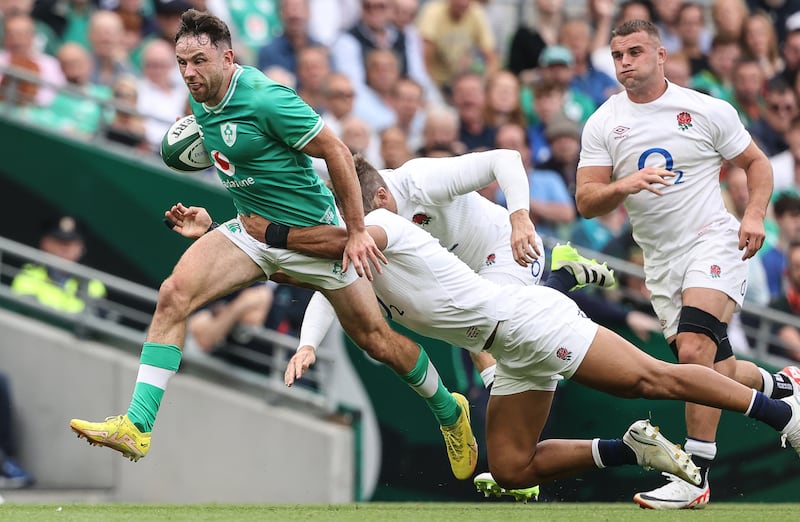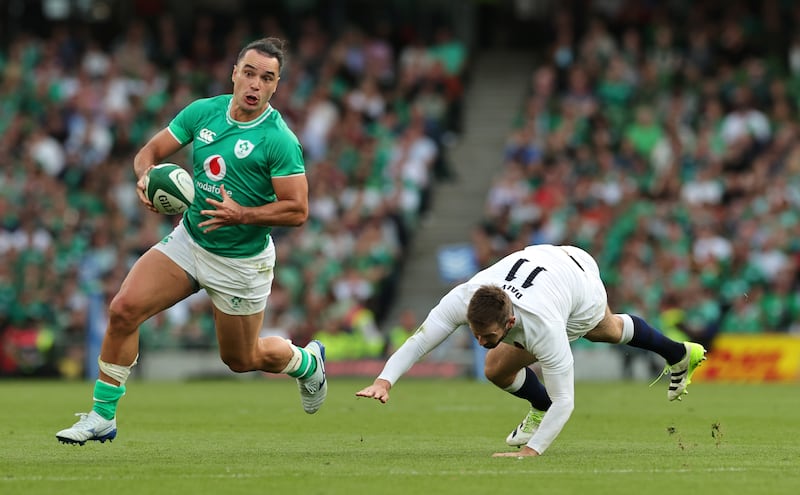Mack Hansen added a dash of colour to Ireland’s victory that went way beyond the superficial, namely the bottle-green hair dye that served to amplify the initials ‘K’ and ‘E’ and the number 100, a haircut homily to his team-mate and Irish rugby’s latest centurion, Keith Earls.
No, it was the nature and artistry of Hansen’s performance that provided brushstrokes of real quality, the footwork, evasion, aerial assurance, the vision, the ability to execute accurately both in attack and defence, all neatly parcelled in a flesh and blood bundle of exuberance.
He was in good company, as he had been for 80 minutes on the pitch at the Aviva Stadium, part of a back three that included fullback Hugo Keenan and left wing James Lowe, one of whom was odds-on to be crowned man-of-the-match. There’ll be no grumbles that he touched off his team-mates in that context.
There is no shortage of moments to isolate the individual excellence, but it was their periodic collaborations that were arguably the most pleasing.
READ MORE
Hansen and Lowe busied themselves in popping up in less orthodox field positions than their respective jersey numbers would indicate, both from set plays and when Ireland got a few chances to freestyle following turnover possession.
An early illustration came from a trick lineout play, Tadhg Beirne winning it at the tail without jumping, and in jig time Lowe, materialising from the blindside wing, appeared outside the midfield axis and put a touchline-hugging Hansen in space. Hansen did extremely well to make metres by cutting back against the grain and sidestepping a couple of tacklers.
If that represented a notice of intent, the pair doubled down on 37 minutes. Lowe, sneaking into midfield from the blindside wing, made the initial breach thanks to his line and Garry Ringrose’s deft short pass, linked with Keenan who in turn found Cian Prendergast. A couple of phases later, Lowe hit Peter O’Mahony with a zippy, long pass on the other touchline.

In the next sequence of play Hansen’s pinpoint crosskick, a reminder of a previous incarnation as an outhalf, led to a nicely finished try by Ringrose. On 54 minutes the pair work in tandem again, a precursor to Lowe’s try.
They also enjoyed their time apart, Lowe’s thumping 70-metre clearance lifting a rare English foray inside the Irish 22, while on a couple of occasions Hansen made good defensive reads, stepping in, to nail Freddie Steward and Elliot Daly with man-and-ball tackles.
England initially, through Ben Youngs and George Ford, rained high balls down on top of Hansen, too many to be coincidental, but the Irish wing was impervious to the deluge. And all the while Keenan played with an unflustered elegance that has been the stock of his trade in the fullback position.
His positional play was first class from the opening moment in the contest in which he fielded Youngs’s box-kick, beat the first tackler and immediately provided his team with front-foot ball, to a late cameo some 77 minutes later in which he thwarted an English counterattack.
In between, he demonstrated many attributes on both sides of the ball, one particularly eye-catching intervention was his foot speed to win the race to a George Ford kick through, having started in lane eight.
Keenan’s instinct is to run, and he’ll regularly beat the first chaser or occupy two opponents in the tackle. He works hard to support his wings and chases kicks, his own or others, with an unfiltered focus and enthusiasm.

In zoning in on him and his hinterland, the backfield he patrols, there is scope for Ireland to tweak the game plan from time to time to make them even more dangerous. It is a relatively minor tweak but one that could offer a nice return, so to speak.
There were half a dozen occasions when England kicked poorly, compounded by a lethargic kick-chase, giving Ireland a great opportunity to counterattack if they were willing and able to muster the numbers. France, Fiji and New Zealand are particularly effective in getting numbers back to support the catcher from loose kicks.
On 25 minutes Ross Byrne fielded a poor punt but only Keenan hustled to offer support, the green escort line ambled back at a similar pace to the chasing English players. There was no urgency or sense of opportunity.
Shortly after the interval Jamison Gibson-Park caught a clearing kick on the Irish 10-metre line and passed inside to Keenan. The next nearest Irish players were 20 metres in front stationary, waiting for the fullback to come towards them running, or pass them as he chased a kick.
Inadvertently, on a couple of other occasions, the Irish backfield was more heavily populated than normal, players either coming back from somewhere or about to set off. The first time Ireland made 40 metres with a passing interplay on counterattack, the second, Keenan took contact, perhaps unaware of the chance to push the ball through the hands into the space out wide.
As the back three so eloquently demonstrated there is no substitute for working hard and smart. Thomas Edison summed it up: “Genius is one per cent inspiration and 99 per cent perspiration”.
















